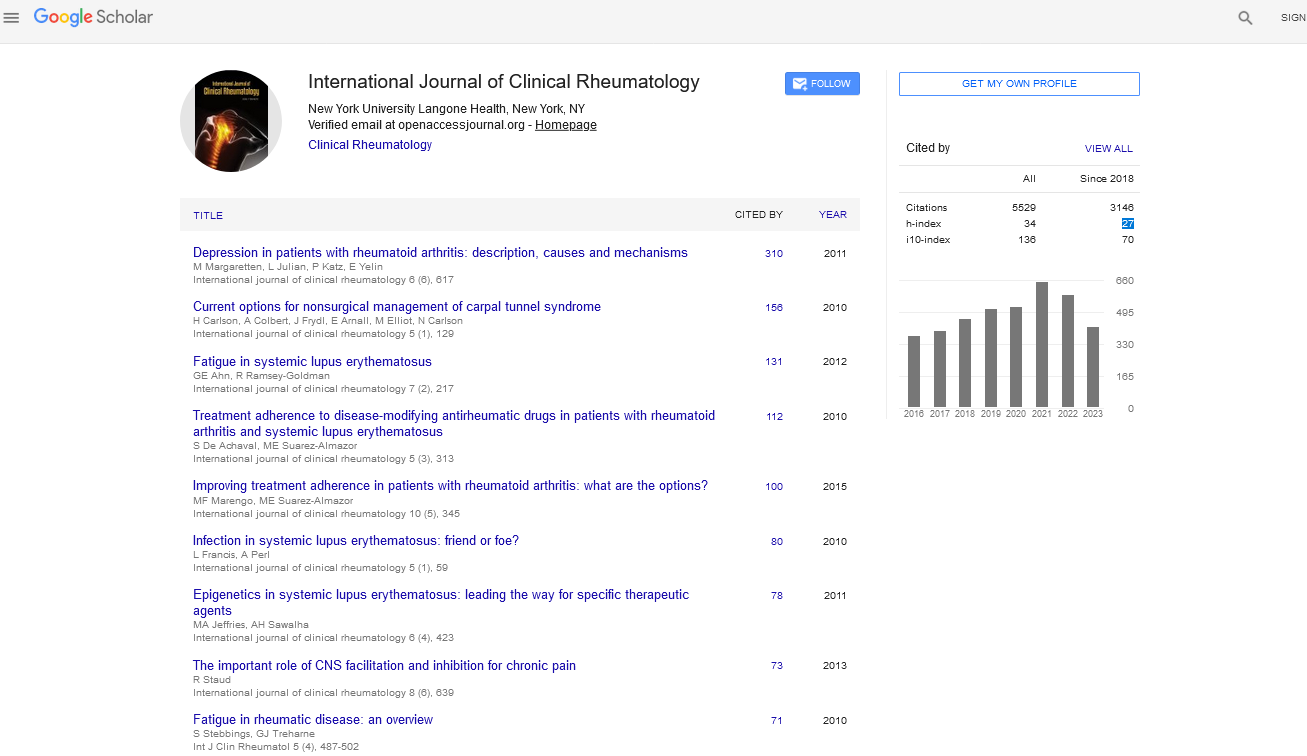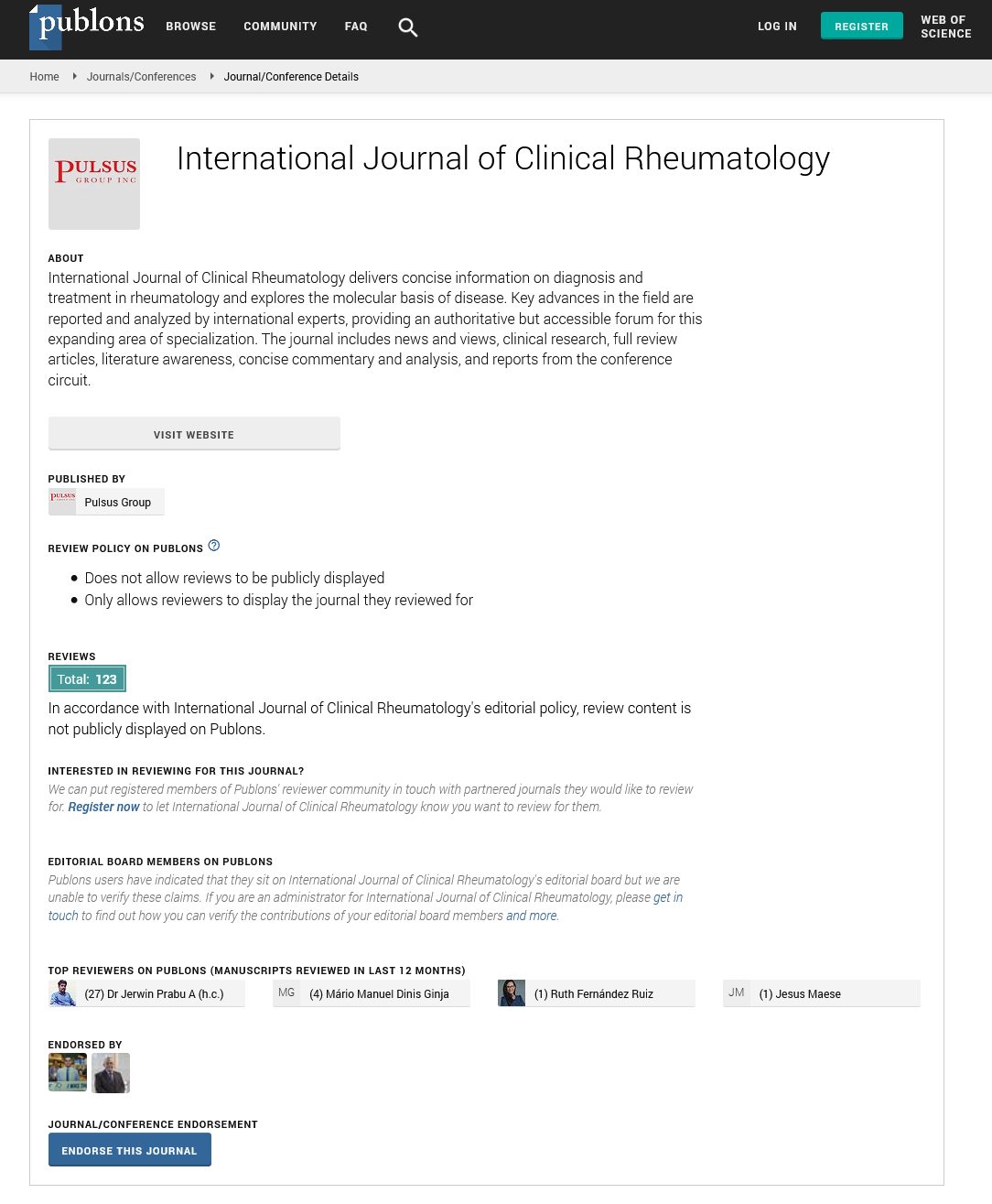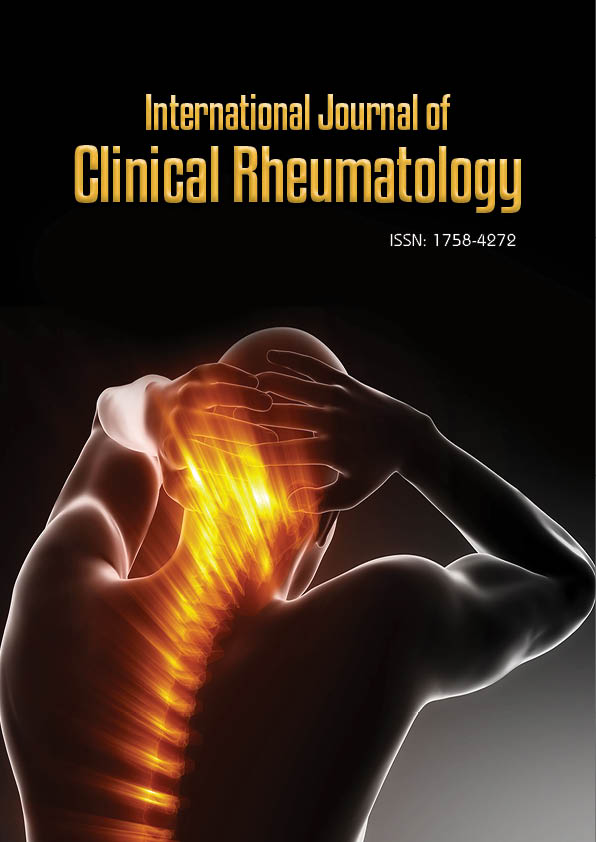Editorial - International Journal of Clinical Rheumatology (2025) Volume 20, Issue 1
The Role of Biologics in Rheumatoid Arthritis: Efficacy and Safety
Lucas Martinez*
Division of Rheumatology, University of Cape Town, Cape Town, South Africa
- *Corresponding Author:
- Lucas Martinez
Division of Rheumatology, University of Cape Town, Cape Town, South Africa
E-mail: lucas.martinez1992@zoho.com
Received: 02-Jan-2025, Manuscript No. fmijcr-25-162969; Editor assigned: 04- Jan-2025, Pre-QC No. fmijcr-25-162969 (PQ); Reviewed: 18-Jan-2025, QC No. fmijcr-25-162969; Revised: 23-Jan-2025, Manuscript No. fmijcr-25-162969 (R); Published: 30-Jan-2025, DOI: 10.37532/1758- 4272.2025.20(1).386-389
Abstract
Rheumatoid arthritis (RA) is a chronic inflammatory disease that predominantly affects the joints, leading to pain, stiffness, and irreversible joint damage. While conventional disease-modifying antirheumatic drugs (DMARDs) have been the mainstay of treatment, biologic agents have revolutionized RA management in recent decades. This article reviews the role of biologics in the treatment of RA, focusing on their efficacy, safety profile, and long-term impact. We explore the mechanisms of action, advantages over conventional therapies, and potential risks associated with biologics. Current clinical evidence supports the effectiveness of biologics in achieving remission and reducing disease progression, but their use requires careful monitoring due to potential adverse effects such as infections and malignancy. Additionally, the cost of biologic agents remains a concern, especially in resource-limited settings. Future research should focus on optimizing treatment regimens and exploring biosimilars as cost-effective alternatives.
Keywords
Rheumatoid arthritis• Biologic therapies• Disease-modifying antirheumatic drugs• Efficacy• Safety• TNF inhibitors• IL-6 inhibitors• JAK inhibitors• Remission• Long-term outcomes
Introduction
Rheumatoid arthritis (RA) is a chronic autoimmune disease that primarily affects the synovial joints, causing inflammation, pain, and eventual joint destruction. It affects approximately 1% of the global population, with a higher prevalence in women. Despite advances in early diagnosis and management, RA remains a leading cause of disability, significantly impacting quality of life. The advent of biologic therapies has changed the landscape of RA treatment, offering the potential for disease modification and long-term remission. Biologics, which include tumor necrosis factor (TNF) inhibitors, interleukin-6 (IL-6) inhibitors, and Janus kinase (JAK) inhibitors, target specific components of the immune system to reduce inflammation and halt disease progression. While biologic agents have demonstrated significant efficacy, their safety profile has raised concerns. Infections, malignancies, and cardiovascular risks are among the potential adverse effects associated with biologics. Additionally, the high cost of biologic drugs presents a challenge in many healthcare systems. This article aims to critically examine the efficacy and safety of biologic therapies in RA, considering both clinical trial data and real-world evidence [1-4].
Methods
This article is based on a comprehensive review of the literature published from 2000 to 2024, including clinical trials, meta-analyses, and observational studies on biologic therapies in RA. We selected studies that provided data on the efficacy and safety of TNF inhibitors (e.g., infliximab, etanercept), IL-6 inhibitors (e.g., tocilizumab), and JAK inhibitors (e.g., tofacitinib). We focused on studies involving adults diagnosed with moderate to severe RA, and included both head-to-head trials comparing biologics to conventional DMARDs and studies examining the long-term outcomes of biologic treatment. Safety data were evaluated based on reported adverse events, including infections, malignancies, and cardiovascular issues [5].
Results
Efficacy of biologics
Clinical trials have consistently shown that biologic therapies significantly reduce disease activity in RA patients. Tumor necrosis factor (TNF) inhibitors, such as infliximab and etanercept, have demonstrated substantial improvements in disease activity scores (DAS28) and clinical remission rates. A meta-analysis of 18 studies found that TNF inhibitors were associated with a 40-50% higher likelihood of achieving low disease activity or remission compared to traditional DMARDs. Similarly, interleukin-6 (IL-6) inhibitors like tocilizumab have been shown to reduce RA symptoms and slow radiographic progression. In the pivotal studies, tocilizumab was associated with improved physical function and reduced joint erosion in patients with moderate-to-severe RA who had an inadequate response to conventional DMARDs. JAK inhibitors, such as tofacitinib, offer another promising approach by targeting intracellular signaling pathways that contribute to RA inflammation. In clinical trials, tofacitinib has been shown to improve symptoms, reduce disease activity, and delay the need for joint replacement surgery. A study comparing tofacitinib to methotrexate found that patients receiving tofacitinib had superior clinical responses, with more patients achieving remission. Despite their efficacy, biologic therapies are not without risks. Infections are among the most common adverse events, as biologics suppress the immune system. A large cohort study found that patients treated with TNF inhibitors had an increased risk of serious infections, including tuberculosis, bacterial infections, and fungal infections. The risk was particularly high in patients with comorbid conditions such as diabetes or immunosuppression [6].
Malignancy is another concern associated with biologics, particularly TNF inhibitors. While the risk of cancer is generally low, some studies have reported an increased incidence of lymphoproliferative disorders and solid tumors in patients receiving TNF inhibitors. However, other studies have failed to establish a clear link between biologics and cancer risk. A meta-analysis of 21 trials found that the overall risk of malignancy was not significantly higher in patients treated with biologics compared to conventional DMARDs.
Cardiovascular risks are also under investigation, particularly in patients receiving JAK inhibitors. Recent studies suggest that tofacitinib may be associated with an increased risk of major cardiovascular events, including heart attack and stroke. This finding is concerning, especially given that RA patients are already at an elevated risk for cardiovascular disease due to chronic inflammation [7].
Cost considerations: One of the major barriers to the widespread use of biologics is their high cost. Biologic drugs can be prohibitively expensive, particularly in low-income countries. Biosimilars—biologic products that are highly similar to the reference drugs—offer a potential solution to this issue, providing a more affordable alternative. Studies suggest that biosimilars may offer similar efficacy and safety profiles as the original biologics, but at a reduced cost. The increasing availability of biosimilars has the potential to improve access to biologic therapies and reduce healthcare costs.
Discussion
Biologic therapies have transformed the treatment of RA, providing patients with a chance to achieve disease remission and prevent joint damage. TNF inhibitors, IL-6 inhibitors, and JAK inhibitors have all demonstrated efficacy in reducing disease activity, improving physical function, and preventing radiographic progression. These therapies offer significant advantages over conventional DMARDs, especially for patients with moderate-to-severe RA who have not responded to traditional treatments. However, the safety profile of biologics remains a concern. The risk of infections, malignancies, and cardiovascular events requires careful patient selection and ongoing monitoring. Patients on biologics should be screened for latent infections such as tuberculosis before starting treatment, and routine surveillance for malignancies and cardiovascular events is essential during long-term therapy. The decision to initiate biologic therapy should be based on a thorough risk-benefit assessment. The high cost of biologic therapies remains a significant challenge. While biosimilars offer a promising solution, their uptake has been slow in some regions. Healthcare systems must find ways to ensure equitable access to biologics, particularly for patients in low- and middle-income countries. Future research should focus on optimizing biologic treatment regimens, identifying biomarkers to predict response to therapy, and exploring the long-term safety of biologics [8-10]. Personalized medicine, which tailors treatment based on individual patient characteristics, may offer a way to improve outcomes while minimizing risks.
Conclusion
Biologic therapies have revolutionized the treatment of RA, offering significant improvements in disease outcomes and quality of life for many patients. While biologics are effective in reducing disease activity and preventing joint damage, their use is associated with potential risks, including infections, malignancy, and cardiovascular events. These therapies should be prescribed with careful consideration of the patient's overall health status and comorbidities. Biosimilars represent an exciting development in improving access to biologic therapies, particularly in resource-limited settings. As our understanding of RA and biologic therapies continues to evolve, future research will likely focus on optimizing treatment regimens and identifying strategies to reduce the risks associated with biologic use.
References
- Abolfazl Akbarzadeh. Liposome: Classification, Preparation, and Applications. Nanoscale Res Lett. 8, 102 (2013).
- Goyal M.Endovascular thrombectomy after large vessel ischaemic stroke: a meta- analysis of individual patient data from five randomised trials. Lancet. 22, 416-430 (2016).
- Hamdi Nsairat. Liposomes: Structure, Composition, Types, and Clinical Applications. Heliyon. 8, 9394 (2022).
- Berkhemer OA.A randomized trial of intra-arterial treatment for acute ischemic stroke. N Engl J Med. 14, 473-478 (2015).
- Harrison Paul. How shall I say it? Relating the nonrelational .Environ Plan A. 39, 590-608 (2007).
- Vukasinovic.Real Life impact of anesthesia strategy for mechanical thrombectomy on the delay, recanalization and outcome in acute ischemic stroke patients. J Neuroradiol. 95, 391-392 (2019).
- Carrillo JE, Carrillo VA, Perez HR et al. Defining and targeting health care access barriers. J Health Care Poor Underserved. 22, 562-75 (2011).
- Carrillo JE, Carrillo VA, Perez HR et al. Defining and targeting health care access barriers. J Health Care Poor Underserved. 22,562-75 (2011).
- Peng J, Luo F, Ruan G et al. Hypertriglyceridemia and atherosclerosis. Lipids Health Dis. 16, 233 (2017).
- Kooman JP, Kotanko P, Stenvinkel P et al. Chronic kidney disease and premature ageing. Nat Rev Nephrol. 10, 732-742 (2014).
Indexed at, Google Scholar, Crossref
Indexed at, Google Scholar, Crossref
Indexed at, Google Scholar, Crossref
Indexed at, Google Scholar, Crossref
Indexed at, Google Scholar, Crossref
Indexed at, Google Scholar, Crossref
Indexed at, Google Scholar, Crossref
Indexed at, Google Scholar, Crossref
Indexed at, Google Scholar, Crossref


